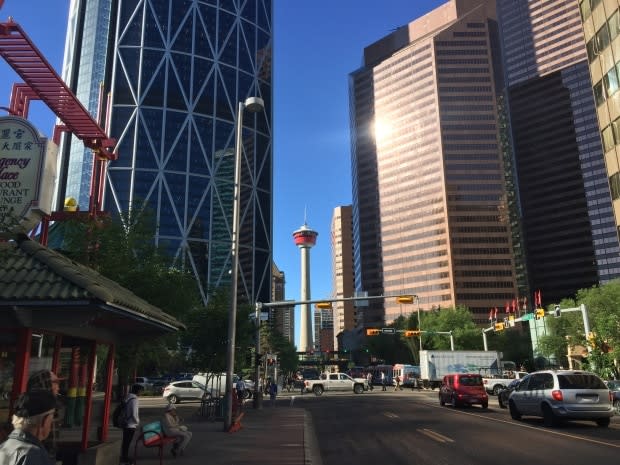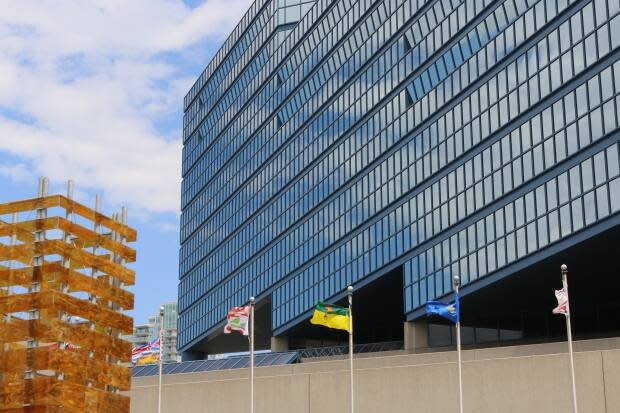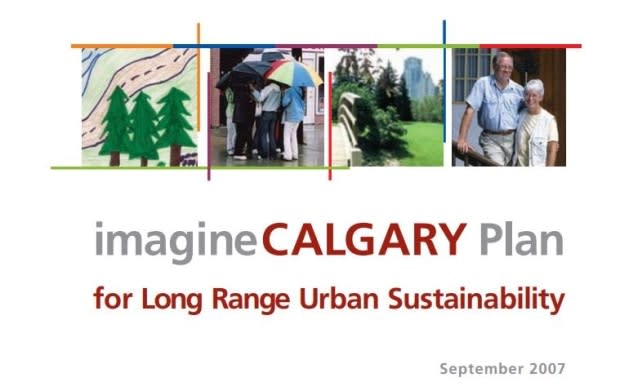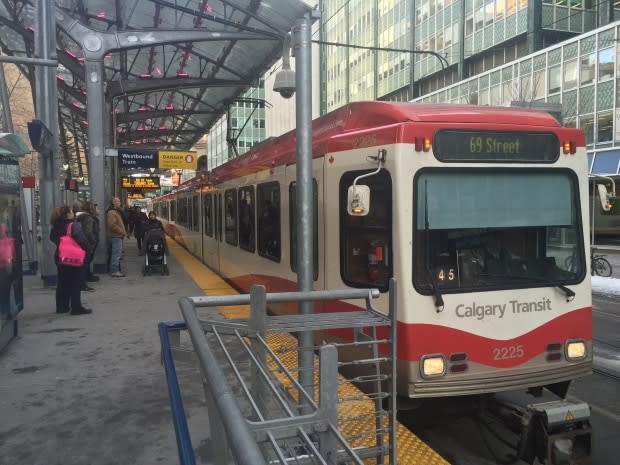OPINION | You may not sense a vision for the future at city hall, but there is one, and it's 211 pages long
This column is an opinion from Dave Robertson, a meeting facilitator and writer in Calgary. He has written about biking in the city, restrictive covenants, stressed-out volunteers and an avalanche burial in Sentinel Pass.

I'm finishing my cup of coffee at Lina's Italian Market when I finally find the courage to ask former Calgary city councillor Bob Hawkesworth whether the current city council has any vision.
Hawkesworth is a polite, optimistic man, and at first he tells me he doesn't want to criticize anyone. But when he looks down at his cup, he closes his eyes and shakes his head.
"I don't sense any vision from council other than.…" He stops himself. "I probably won't go any further or I'll say something quite (negative)." He laughs sadly.
Hawkesworth seems pretty disappointed in our city council right now, and if you've been following municipal politics recently, you might be, too.
A divided city council
November's budget deliberations revealed the divisions among councillors: Green Line LRT versus a new arena, cuts to affordable housing versus a property tax freeze, a demand for wage cuts from city employees, endless debate about "essentials" and "nice to haves."
If our civic politicians share much of a common vision for anything anymore, I'm having trouble seeing it.
That's the problem with the vision thing: it's got a way of vanishing when times gets tough.

I'm a meeting facilitator and I help organizations create the vision statements and strategic plans they hope will lead to a brighter future. I've learned the hard part isn't coming up with ideas — it's all the messy, unexpected stuff that happens after the plan comes out.
One day, the new mission statement is posted in all the meeting rooms. Then something bad happens, the janitors do a deep clean, and it all disappears.
Believe it or not, Calgary has a vision.
'A great place'
Maybe you've forgotten imagineCalgary, or maybe you never knew about it in the first place. But in the rosier days of 2006, 18,000 Calgarians were asked about their hopes and dreams for the city's future.
It was part of a "city-led, community-owned visioning process" that formed this 100-year vision: "Calgary: a great place to make a living, a great place to make a life."
It was accompanied by a plan for sustaining our city's economy, governance, social systems and natural and built environments.
Hawkesworth was on city council when it endorsed the results of imagineCalgary.
Taking the long view
Hawkesworth says that, at the time, the imagineCalgary vision helped councillors focus on important long-term issues and goals.
"This was the impetus that was behind the imagineCalgary process. What would happen if we widely engaged Calgarians to look way into the future and …remove some of the immediate political pressures of the day?"
The 211-page imagineCalgary Long Range Plan for Urban Sustainability has 28 goals accompanied by 114 targets and even more strategies.
While some things seem painfully obvious ("By 2036, all commercial buildings are accessible to people with disabilities.") and others fanciful ("By 2036, 85 per cent of employees express a high degree of job satisfaction."), it names other important aspirations Calgarians hold for things like transit, local business, public spaces and, yes, arenas and stadiums. I have to admire its scope and ambition, but it's not easy to digest and I'm left wondering how many people have actually read it.
As Hawkesworth points outs, imagineCalgary created benefits we enjoy today.
"We've seen the development of bus rapid transit, greater connectivity, an extension of the light rail transit system," he says.
He also credits imagineCalgary with slowing Calgary's notorious sprawl and starting the revitalization of inner-city communities such as Marda Loop and Bridgeland.
David Watson also sees the positives. Watson was the general manager of Planning Development & Assessment at the city during imagineCalgary.
He considers Calgary's waste handling program and better public engagement as good examples.
"These are all movements in the directions or some of the directions that were targets that were in imagineCalgary."
But is imagineCalgary still relevant today? It depends on who you ask.

Still used as guide today
City staff still rely on imagineCalgary to guide their work.
Joe Mueller is the planner leading a review of Calgary's Municipal Development Plan. The MDP describes how Calgary will grow and develop over the next 30 to 60 years.
His colleague, engineer Chris Blaschuk, is working on the Calgary Transportation Plan (CTP), the long-range plan for Calgary's transportation options in the next 60 years. Ironically, the budget for both projects was reduced in last summer's budget cuts.
Nonetheless, Blaschuk has engaged with the public, and says much of imagineCalgary still rings true for the Calgarians he's spoken with.
Mueller says it's because imagineCalgary is broad enough to accommodate our shifting priorities.
"In the last few years, the economic downturn … will play a larger role in all Calgarians' priorities. So many of the things we're doing right now are focused on ensuring that the economic side of sustainability is advanced."
He also believes that city council's priorities are inspired by imagineCalgary.
"For example. 'A safe and inspiring city of safe neighbourhoods' is a council priority that is very well linked to imagineCalgary," he says.
Woolley still passionate
Certainly, Ward 8 Coun. Evan Woolley is passionate about imagineCalgary. It may be because Woolley worked on imagineCalgary as a city employee before he was elected. (Disclosure: I've facilitated community meetings and committee workshops held by Coun. Woolley.)
Woolley credits former mayor Dave Bronconnier for imagineCalgary. "He was the driving force of … actually allowing citizens (to ask) 'Who are we going to be as a city?' It was during a time when immense, vast amounts of wealth like had never been seen on the planet before were pouring into our coffers."
But when I ask about the views of his council colleagues today, Woolley says, "I would say it's a mixed bag.… Most have a sense of where it comes from. Some people fundamentally do not support the imagineCalgary work."
I recognize what he's saying. After asking four councillors for interviews about imagineCalgary, only Woolley agreed to talk.
He tries to remain philosophical.
When Woolley hears some Calgarians say there's no vision at council, he believes it's a sign that this period of political leadership — including his own — may be ending.
"The people that are driving the conversation for the most part, you hear them on city council … are not the people that are wanting to navigate through what is going to be a tough, tough period of time."
He adds, "lowest property taxes is not a vision statement."
'There's no more interest'
Back at Lina's, Hawkesworth tells me that he believes imagineCalgary was abandoned years ago.
"They had an event at Festival Hall (to celebrate the 10-year anniversary of imagineCalgary in 2016). And it felt more like a wake than a celebration because the city was effectively saying, 'There's no more interest. There's no more political interest in it. There's no more administrative interest.'"
Hawkesworth continues: "If imagineCalgary were still alive today, it would be because we had a council that saw and recognized the value of that process and the value of that document and they could draw on it to guide them in making decisions that would be in the long-term interest of the community. So it's an inability to recognize the value of imagineCalgary … hand-in-glove with an inability to articulate a vision of what they want to see the future of the city to be."
He says today's city council is trapped in a cycle of reactive decision-making. I'm inclined to agree with him.

Watson also has mixed feelings about imagineCalgary's fate.
"If there was something that I'm feeling a bit regretful of, we probably did not … spend enough time thinking about how we transfer this from city-led, community owned to … an infrastructure in the community that would sort of be the engine to move it forward and keep talking about it and using it," Watson says.
This is where Calgary's official vision sits today. Most Calgarians have either forgotten about it or didn't know it existed. Some on city council don't support it. City staff continue to use it.
Take imagineCalgary out of the vault
So, what do we do now?
Hawkesworth says it's not too late to "resurrect imagineCalgary, to take it out of the vault, use it as a template to create an engagement process for key stakeholders and citizen groups."
He says it's important to get this done before the end of this council's term.
"That might be (imagineCalgary's) second gift," he says.
Woolley agrees it might be important to review imagineCalgary but doubts this city council is in the proper frame of mind right now.
"I don't know if today is that time. I think we are working through a pretty difficult era of how we talk to each. We have become very binary or emotional," Woolley says.
After talking to Woolley and Hawkesworth, I want some advice on this whole vision thing, so I contact Peter Block.
Block describes himself as a citizen of Cincinnati, Ohio, but he's actually a retired management consultant who's written some highly regarded books about citizen dialogue and building stronger communities.
Like Woolley, he doesn't believe that our political leaders have many answers.
"The group least capable of navigating this paradox is city council," Block says. "They're amateurs, most of them. They care about the city, God bless them, they're going to so many meetings, but they're trying to figure this out, and the corporate mindset that says a new stadium (is the solution) … is always compelling."
Calgary's dilemma
He summarizes Calgary's current dilemma this way: "That was a nice ride and the old vision statement was the saddle on top of that ride, and now something has changed, that the illusion of progress, infinite, forever progress, is being stolen."
Block says the most important question Calgarians need to explore right now is, "How does the city and the community come to terms with the shift in (an economic) narrative it didn't choose?"
Most importantly, he calls on Calgarians to reclaim their roles as citizens.
"If you call citizens 'customers' or 'consumers,' you let them off the hook. You say, 'We're here to satisfy you.'
"Citizens are human beings and have the capacity to produce their own well-being."

Hawkesworth says some Calgarians are already choosing to step up with their own vision for the city's future.
"It should not be lost on anyone that there were 200 citizens there on Monday morning (during budget deliberations) telling city council, 'We have a vision … we do not want you to balance this budget on the backs of the poor and the vulnerable in our community.'"
He continues: "I've never seen that, even during imagineCalgary. We never saw the galleries jam-packed with citizens. This is just something new.
"And I think it's because citizens feel that there is no vision collectively from city council … they're stepping in to help fill that gap."
I start to feel a little closer to a solution, but I wonder what it's going to take to get more Calgarians involved in setting a new course for the city's future.
Desperate for an idea, I take another flip through imagineCalgary and see this goal: "Calgary is a city with a vibrant, resilient, environmentally sound and sustainable economy that fosters opportunity for individual economic well-being."
To me, it sounds like a good place to start.
This column is an opinion. For more information about our commentary section, please read this editor's blog and our FAQ.


